The sinners are in the Church also. The sinners too? Of course, the
sinners too. God never shuts them out. He keeps them within His body
until the very last moment, tied to Him, so
that they don’t ever despair at all, and the despair doesn’t overwhelm
them, and they don’t lose their crown. “You too, who are a sinner,” says
Christ, “are my child, part of my body. Courage then, my child, in your
struggle and you will triumph! If you want, I’ll give you even more
grace and in the end we will find ourselves in heaven together.” . . .
The Church is the Body of Christ. This means that all of us, since we
all belong to the body of the Church, are no longer independent bodies,
but are members of hers. I am one hand, you the other. You are an eye,
he the other. Each of us is one member (1 Cor 12:14-18). Therefore we
must not look at another with indifference and coldly, but with
tender-hearted love. My hand hurts? I will suffer. That is, we are to
see the other people as our hand. We are to love them.
Based on Elder Aimilianos of Simonopetra, may his memory be eternal
In this old photo is Elder Aimilianos with Elder Joseph of Vatopaidi (A smile from eternity)
Biographical details by Hieromonk Serapion Simonopetritis
On the morning of 9 May 2019, Archimandrite
Elder Aimilianos, former Abbot of the Holy Monastery of Simonos Petras
on the Holy Mountain fell asleep in the Lord at the Holy Convent of the
Annunciation of the Mother of God, Ormylia, Halkidiki.
You have made known to me the ways of life; you will fill me with joy with your countenance (Ps. 15, 11)
Elder Archimandrite Aimilianos, born
Alexandros Vafeidis, was Abbot of the Holy Monastery of Simonos Petras
from 1973 until 2000. He was born in Nikaia, Piraeus, in 1934, to devout
parents, though by ancestry he was from Asia Minor. His grandmother on
his father’s side, Evdoxia, was Constantinopolitan, while his
grandfather was from Silivria in Thrace and had studied at the famous
Theological School of Halki. In 1906, they moved to Simantra, in the
blessed region of Cappadocia, where they served as teachers to the Greek
population. After the Asia Minor catastrophe, they went to Greece,
because of the exchange of populations. Though married, they lived as
monastics, praying and keeping vigils. His grandmother went to her
repose as a nun, with the name Eftaxia as did his mother, with the name
Aimiliani.
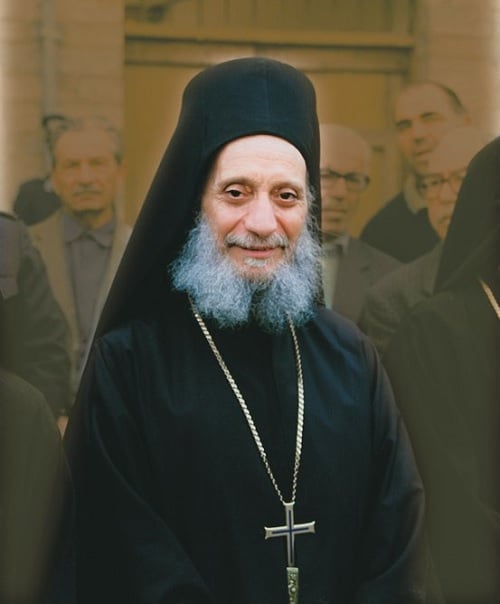
The Elder inherited his spiritual and
bodily gifts from his grandfather and from his grandmother he gained
indelible spiritual experiences. From childhood he bore within him the
desire to devote himself to God and applied himself to the study of the
Gospel and many Patristic books and to the unceasing repetition of the
Jesus Prayer, from which he drew authentic answers and divine
inspiration concerning the course of his life.
He attended primary school in Simantra*,
Halkidiki, where his grandmother had settled and secondary school in
Nikaia, Piraeus, where his parents were. He was an excellent student. He
continued his studies at the University of Athens, initially in the
School of Law, at which he spent two years before transferring to the
School of Theology, where he could be trained in accordance with the
inclinations of his soul.
During the course of his university
studies, with a group of like-minded friends from his high school days,
he became very active, organizing Sunday schools, talks and other events
which allowed his spiritual, leadership and organizational gifts to
shine. When he’d completed his studies, because of the prevailing
thinking at that time, he considered the priesthood, with external
mission as the ultimate goal. He judged that it would be better,
however, to begin his preparations for this task in a monastery. He
turned to Metropolitan Dionysios of Trikka [Trikala] and Stagi, who had
just assumed his pastoral duties and was reputed to be a supporter of
monasticism.
Elder Aimilanos’ tonsure as a monk
He came to Trikala in 1960 and placed himself at the disposal of the
leader of the flock, who on 9 December 1960, tonsured him and gave him
the name Aimilianos. He was registered as a monk at the Holy Monastery
of Saint Vissarion, in Dousiko. On the 11th of the same month His
Eminence Dionysios ordained him deacon in the church of Saint Paraskevi,
Trikala. He was thereafter sent to various monasteries in Meteora,
which were going through a time of shortage as regards numbers of monks.
Then, on the feast of the Dormition of the Mother of God, in the year
1961, he was ordained to the priesthood at the Holy Monastery of
Vitouma.
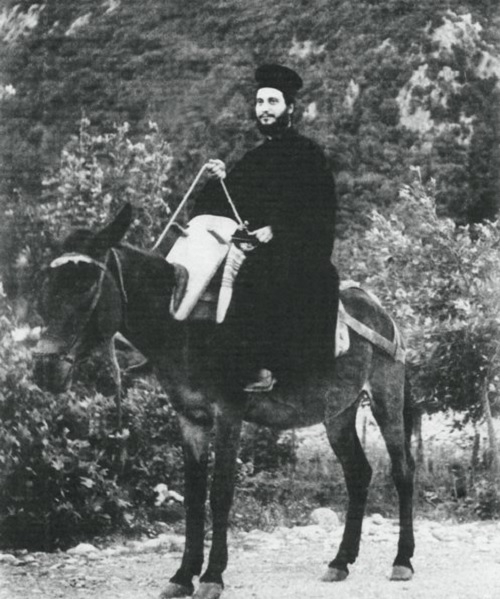
Elder Aimilianos at Dousiko
After his ordination to the priesthood
he lived for four months, that is until December of that year, at the
Holy Monastery of Saint Vissarion, at Dousiko. In that deserted and
isolated spot he lived in complete seclusion and quietude, fervently and
intensively seeking God, ‘Who saves us from storms and from
faintheartedness’. In His providence, the Lord paid heed to his mystical
pleas, appeared to His servant and, transfiguring his existence in the
fire, revealed to him ‘the path of life’.
He now turned with might and main to the
monastic life. All that was left of it at that time was a shadow of
what it had once been, but with invincible courage and soaring hope he
envisioned its revival and renewal.
*Many of the places where Greeks from Asia Minor settled were named after their original home town.
Abbot of the Great Meteora and multi-faceted activity in the Metropolis of Trikka
At the end of 1961, the Metropolitan of Trikka, who shared Fr. Aimilianos’ desire for the monastic life, called him back from Dousiko and made him Abbot of the Holy Monastery of the Transfiguration at the Great Meteora. Initially he was there alone, but, despite his always fragile health, he found strength in high-minded fortitude and the tireless pursuit of the ascetic, mystical and sacramental life. He kept vigils, prayed unceasingly and devoted himself to the most painstaking and lengthy study of Patristic, ascetic and ecclesiastical works. With an insatiable appetite, he sought, found and studied every text dealing with the organization and functioning of Orthodox monasticism, particularly the coenobitic form [common life in a monastery], delving into the monastic institutions of the Eastern Orthodox Church and the Rules of prominent ancient monasteries.
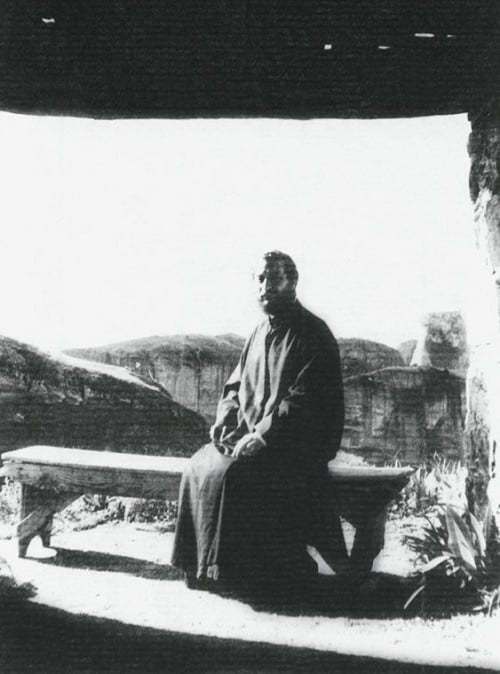
Elder Aimilianos in the pavilion of the Monastery of the Great Meteora (1963)
Although his way of life was purely
ascetic, on 1 January, 1962, the metropolitan raised him to the rank of
archimandrite and assigned to him the task of preaching and confessing
and of training the young people in the diocese, making him
priest-in-charge of the church of the Divine Visitation, dedicated to
the Mother of God, in Trikala. Calm, always charming and approachable,
with a suitably clerical demeanour and a noble air, he celebrated the
liturgy almost every day from then on until he fell ill. He lived and
thrived on the Bread of Life: ‘Bringing God into his vital organs and
flashing shafts of divine lightning’ he emerged from his caves like a
burning lamp, enlightening the faithful and casting his net for the
people of God with his Spirit-filled sermons, educating them ‘in all
spiritual wisdom and understanding’.
Young people and children flocked to
confess to him, and on these he unstintingly spent time, effort, tears,
prayer, ‘and even his own soul’. A new period began then in the life of
the venerable Elder. He was no longer alone; he’d become a ‘father’, for
many ‘sons and daughters of God’. He felt himself to be, and lived as, a
real apostle. His life was devoted to his children in all freedom,
without any expectation at all of the slightest recompense or reward.
From this host of people, a good number began to consider the monastic
life, and, as time went by, the first nucleus of the brotherhood of the
Monastery of Meteora was formed. Some of the others were more inclined
towards clerical status or family life, though all remained a broader
spiritual family with the monastery at its centre.
In 1963, the first two monks moved into
the Great Meteora, and, at the end of the school year 1965-66, a large
group of high school students went to live as novices under his
guidance. On August 6, 1966, his Elder, Metropolitan Dionysios, tonsured
him a monk of the Great Habit. The life at Meteora and the progress of
his young but charismatic spiritual son brought great joy to the heart
of His Eminence and filled it with high hopes. While Fr. Aimilianos was
establishing the monastic life at Meteora he was advised by and
developed spiritual relations with a number of modern, saintly figures:
Fr. Athanasios Hamakiotis, Papa-Dimitris Gangastathis, Elder [now Saint]
Amfilohios of Patmos, Filotheos Zervakos, Simon Arvanitis and
Damaskinos Katrakoulis. At that same time, he also met now distinguished
Serbian bishops who were then students at the University of Athens and
spiritual children of that pillar of the Serbian Church, Saint Justin
Popović. Later, in 1976, by which time he was already Abbot of the Holy
Monastery of Simonos Petras, Elder Aimilianos would visit Fr. Justin in
Serbia. It was also at this time that the Elder began his pilgrimages to
the Holy Mountain, from which he gained a rich store of spiritual
experiences. He became acquainted with Elder [now Saint] Païsios, and at
the far end of the Athos peninsular, he met the great athlete of
obedience Papa-Efraim Katounakiotis [now Saint]. Thereafter, a special spiritual
bond developed between the two men, concerning which the godly
Papa-Efraim would often say: ‘I found my lost Elder, another Iosif, the
golden-tongued and venerable Elder Aimilianos’ [Papa-Efraim had been a
spiritual son of Elder Iosif the Hesychast].
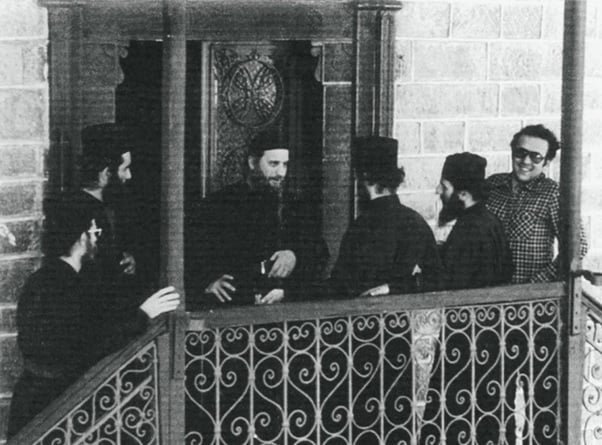
Elder Aimilianos at the entrance of the Abbot’s lodgings at Simonopetra
In 1968, with the tonsuring of the then
young novices, the brotherhood of Meteora was formed and with profound
perception or rather foresight Elder Aimilianos laid the foundations for
their coenobitic life. With his gift of insight, he chose and promoted
the then high school student Emmanuel Raptis as his successor and the
latter is now the Right Reverend Archimandrite Elissaios, Abbot of
Simonos Petras. In the year 1972, after years of trials and
tribulations, the time had come to form the initial nucleus of a female
monastic community, which, under the care and guidance of Abbess
Nikodimi, settled temporarily in the Holy Monastery of the Saints
Theodore, close to Meteora. While this female community was still in its
infancy, the wise Elder was already drawing up its internal Rule- his
spiritual testament and his only written work- which was given to the
sisters on 5 May 1975, when they had already settled into the dependency
in which they live today [Ormylia].
Election to the office of Abbot of the Holy Monastery of Simonos Petras
After the unexpected departure to the
Lord of Metropolitan Dionysios in January 1970, the need for a place
which would guarantee more peace and be more suitable for the monastic
life of the brotherhood, away from the noise and the tourism which
afflicted Meteora, as well as the insistent invitation of the Holy
Monastery of Simonos Petras, which was suffering from a lack of monks at
the time resulted in the brotherhood transferring to the Holy Mountain
at the end of 1973. Since the position of Abbot of the monastery was
vacant, following the demise of Archimandrite Haralambos, Elder
Aimilianos was elected by the members of the old brotherhood to the
post, in accordance with the Athonite rules. He was enthroned on 17
December by the Holy Community. The installation of the brotherhood from
Meteora was welcomed by the Athonite fathers, bringing with it, as it
did, hopes for the future. And, indeed, other communities followed,
making for a considerable increase in the number of monks on the Holy
Mountain.
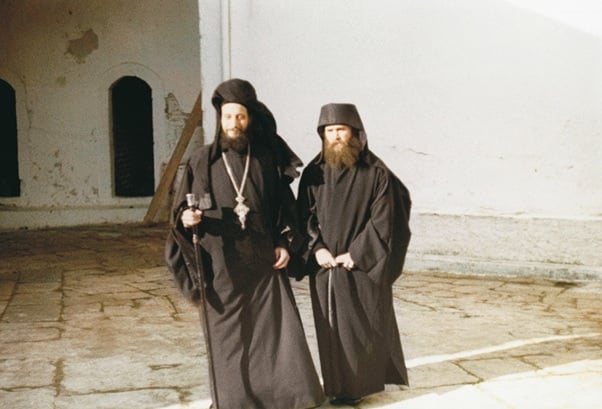
Simonopetra.
With the then Abbot of the Holy Monastery of Filotheou, Archimandrite
Efraim (1973) [Note the poor state of repair of the buildings the Elder
inherited. They aren’t like that now].
In addition to his vigilance,
celebrating the Divine Liturgy and his other duties, he threw himself
into the task of reorganizing the internal life of the new brotherhood.
With wisdom and discretion he adopted the Athonite tradition, with its
existing Rules and adapted them with his own personal seal- ‘attending
to the divine canons’ of the holy Fathers whom he loved so much and,
with a burning thirst and much effort, brought back to the fore- thus
creating the Rule of the monastery. With respect and love for the
experience of the older monks, he focused the youthful enthusiasm, zeal
and dedication of the younger ones, greatly increasing the size of the
brotherhood. With his administrative abilities in general and the
paternal guidance of his flock, he restored the status and highlighted
the centuries-old tradition of this long-famed Holy Monastery.
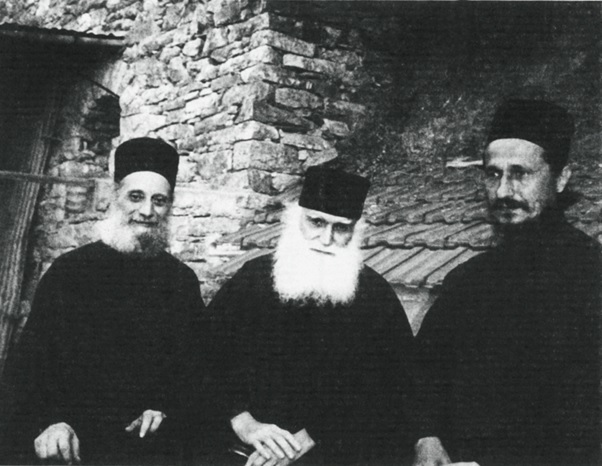
Elder Aimilianos at Katounakia with the late Elder Efraim [Katounakiotis] and the Serbian Metropolitan Atanasije Jevtić
Organization and refurbishment of the dependencies of the Holy Monastery of Simonos Petras in Greece and abroad
Once the community was settled on the
Holy Mountain, he also interested himself in a paternal manner in the
establishment of the women’s community which, on 5 July 1974, had moved
into the old dependency of Vatopaidi, the Annunciation of the Mother of
God at Ormylia. The dependency was bought by Simonos Petras and, with
the approval of the local bishop and the support of the Holy Community,
became a dependency of the monastery and has functioned as such ever
since.
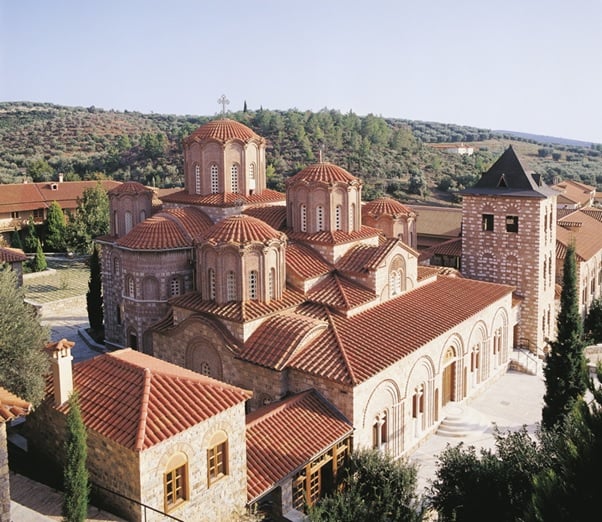
The main church of the Convent of the Mother of God at Ormylia
The Elder worked long and hard on the
renovation of this small dependency, of which he was to become the wise
and inspired co-founder*, since everything had to be started afresh. The
first concern was to buy the land around the dependency, so that the
nuns could live in peace. In 1980, the building renovations began, ‘by
God’s favour and grace’ and with the support of the faithful. Within
about fifteen years, it had became a large convent. His joy and emotion
knew no bounds when the main church of the dependency was inaugurated by
Metropolitan Synesios of Kassandria, in whose person they found a
discriminating and understanding hierarch. On October 25, 1991, by a
sigillium, that is a command in the form of a letter from His
All-Holiness Bartholomew, the Ecumencial Patriarch, it was raised to the
status of patriarchal and stavropegic, [which means that it is under
the direct supervision of the Patriachate, rather than that of the local
bishop].
Following the example of the Fathers,
who gave succour to their neighbours in need and affliction, in 1982, he
founded the spiritual and social support centre ‘Our Lady of Charity’.
This was a bequest from the late Captain Ioannis Hatzipateras and it is
run by the nuns of the convent as a humble, altruistic contribution to
the life of the people in the surrounding area.
In the Elder’s eyes, all the monastery’s
dependencies were Simonopetra: Analipsi [the Ascension] in Athens;
Saint Haralambos’ in Thessaloniki, Saint Nikodimos at Pentalofos,
Goumenissa; and, in France, Saint Anthony’s, the Transfiguration and the
Protecting Veil. A special position was occupied by the Archimandrites
Placide Deseille († 2018) and Élie Ragot with their communities. During
the period between 1979 and 1984, with the constant guidance and support
of Elder Aimilianos, the dependencies we mentioned in France were born:
Saint Anthony’s, for men, and the Protecting Veil and the
Transfiguration for women. These represent budding shoots as regards
Orthodox monasticism in the West.
Elder Aimilanos’ withdrawal to the dependency at Ormylia
At the beginning of 1995, permanent damage to his health forced the
venerable Elder to withdraw gradually from his duties as Abbot and leave
his beloved monastery and the Holy Mountain, of which he was so fond.
In 2000, the revered Elder passed the baton of his duties to the present
Abbot of the Holy Monastery of Simonos Petras, the Very Reverend
Archimandrite Elissaios, who, with filial respect is continuing his
work. The Elder himself lived in peace and quiet in the dependency at
Ormylia, ‘supplementing in his body the deficiencies of the sorrows of
Christ for the sake of the body of Christ, that is, the Church’, with
great patience and fortitude.
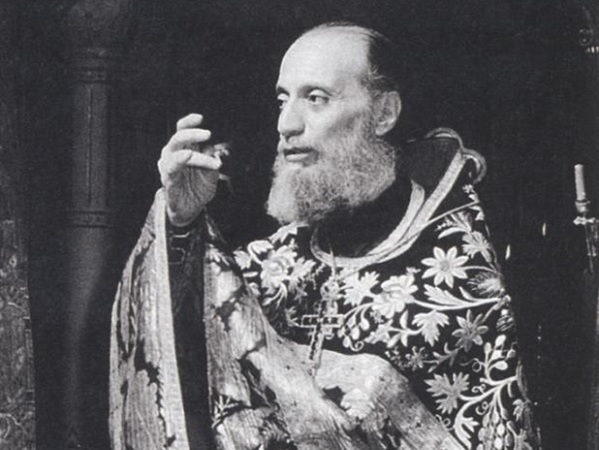
Very few texts from the Elder’s rich
spiritual harvest were published during the time he was active, because
his sole aim at that time was to provide the necessary education for the
sound development of his spiritual children and the flock of the
Church. For this reason, he humbly avoided making his words public.
The Elder’s address was characterized by
an empirical approach to issues, a profound analysis of concepts and a
fluent manner of expression. His instructional homilies are a valuable
legacy and repository for his monks and nuns: a vessel overflowing ‘with
the purest wine’ which, given his later silence, has become ‘invested
with gold and silver’. This wine is preserved by the two communities as a
most precious inheritance and is being poured out to the Church of God
as a labour of love.
The task of organizing his many and
varied spiritual instructions and homilies was undertaken by the women’s
community at the dependency at Ormylia, which also started publishing
them in 1995, inaugurating the Spiritual Instruction and Discourses
series. Four volumes have already been published: The Authentic Seal
(1998), Life in the Spirit (1998) Let us Rejoice in the Lord (1999) and
Divine Worship- Expectation and Vision of God (2001). As well as the
original Greek, the works have also been translated into French,
English, Romanian, Russian and Serbian.
The publication of the eloquent Elder’s
work is a matter of filial love and an expression of eternal gratitude
on the part of his children and it is expected that it will extend into
numerous volumes covering a variety of subjects: homilies and sermons;
interpretations of the ascetic Fathers (Abba Isaiah, Isykhios
[Hesychius] the Elder, Gregory the Sinaite, Maximos the Confessor, Saint
Thalassios, and Saint Theognostos); interpretations of monastic rules,
(those of Anthony the Great, Saint Augustine, Saint Makarios, Saint
Pachomius), monastic institutions and practical life (monasticism, the
monastic rule, the life of the monastic, and the relationship between
elder and disciple; interpretation of the life of the saints (Saint
Nilus the Calabrian, Saint Romylos); interpretations of Biblical
hymnographical and theological texts (psalms, prophesies, hymns and so
on).
The Elder’s tenure as Abbot of the Holy
Monastery of Simonos Petras is already considered to be one of the most
blessed periods in the more recent history of the foundation, of which
it is rightfully proud. It also coincided, by the protection of the
Mother of God, with a massive influx of new monks onto the Holy Mountain
and the enhanced influence of Athos as a whole. As he himself remarked:
‘The monastic community in a coenobitic monastery is essentially living
in the Church, through the Church, like the heart or a bodily member.
It cannot be evaluated on the basis of the activities it engages in, but
rather by its fervent quest for God. In this way, the monks or nuns
prove to be themselves God-like, attracting others to the divine life’
(Rule of the Holy Convent of Ormylia).

Δεν υπάρχουν σχόλια:
Δημοσίευση σχολίου